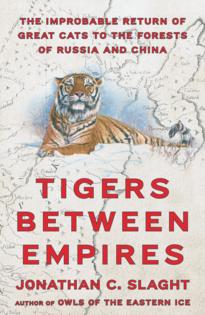Review: An author's 'life-changing' tiger encounters
Published in Books News
Like many an epic Russian tale, “Tigers Between Empires” fittingly opens with a cast of characters, some with two legs, but most with four.
Minneapolis writer Jonathan C. Slaght’s book is a deep look at the Wildlife Conservation Society’s Siberian Tiger Project, which begins in the early 1990s and covers three decades of exhausting research in the remote, frigid Russian Far East landscape of the endangered Amur (also known as Siberian) tiger.
There, a team of U.S. and Russian scientists tracked, collared and observed as one of the world’s largest wild cats hunted, raised cubs and died — often at the hand of man, via poaching, logging and loss of habitat. The main goal was to figure out what these tigers, facing extinction, needed to survive.
To name a few, there’s Olga, Natasha, Katya and Kristina, whose individual personalities and circumstances are at the heart of the best chapters, many of which read like thrillers: Tiger territory is “at once breathtaking and ominous in its beauty.” A deer kill is “a story of violence written in blood and snow.” Angry or captured Amur tigers range from “a furry behemoth quivering with wrath,” “a knot of muscle and rage,” to a creature that “roared with indignation.”
In one heart-pounding encounter, an unlucky hunter finds himself knocked to the ground with a bloody tiger on his chest, mauling him, only for it to roll off to “rest” and then, a few moments later, climb back on to resume the punishment.
Akin to his internationally acclaimed 2020 “Owls of the Eastern Ice,” Slaght again shines his scientific-yet-soulful spotlight on one of the world’s most amazing creatures, so that we might better understand how to live peaceably in one another’s company.
While “Tigers” isn’t a memoir, it’s because of conservationist/wildlife biologist Slaght’s own research and prolonged friendships and treks with the tiger team that he had this front-row seat. “Any glimpse of a wild tiger is memorable,” he writes, because so few people have actually seen them. “But to behold one up close — to see the pink of the nose or feel its chest expand as it breathes — is life-changing. It is a moment in which the mythical becomes real.”
“Between Empires” is aptly named as it takes place along the rugged Russia-China border. But the title is political, as well, in that these mysterious, graceful creatures and their researchers were affected by the swiftly changing attitudes following the fall of the Soviet Union. The wild cats sit, too, in the uncomfortable space between the empires of knowing and unknowing, where an animal is seen as something that is rightfully a part of nature versus as a predator that should be “removed.” Those familiar with Minnesota’s history with the wolf will understand this unfortunate dichotomy.
Early on, Slaght tells naturalist Aldo Leopold’s story of the moment it all changed for him, after he shot a wolf and saw “the green fire” die in her eyes. The green that was extinguished was the reflected green of the natural world.
The tigers at the heart of this fascinating survival-revival tale are individual souls, part of that ancient relationship to which we all belong: nature. How to save them? It’s complicated. But near the end, a farmer decides not to shoot a tiger because he has come to believe that she was “as much a part of this place as he was.”
This, Slaght notes with an air of success, was tiger conservation working on a personal level.
____
Tigers Between Empires: The Improbable Return of Great Cats to the Forests of Russia and China
By: Jonathan C. Slaght
Publisher: Farrar, Straus & Giroux, 512 pages.
©2025 The Minnesota Star Tribune. Visit at startribune.com. Distributed by Tribune Content Agency, LLC.












Comments